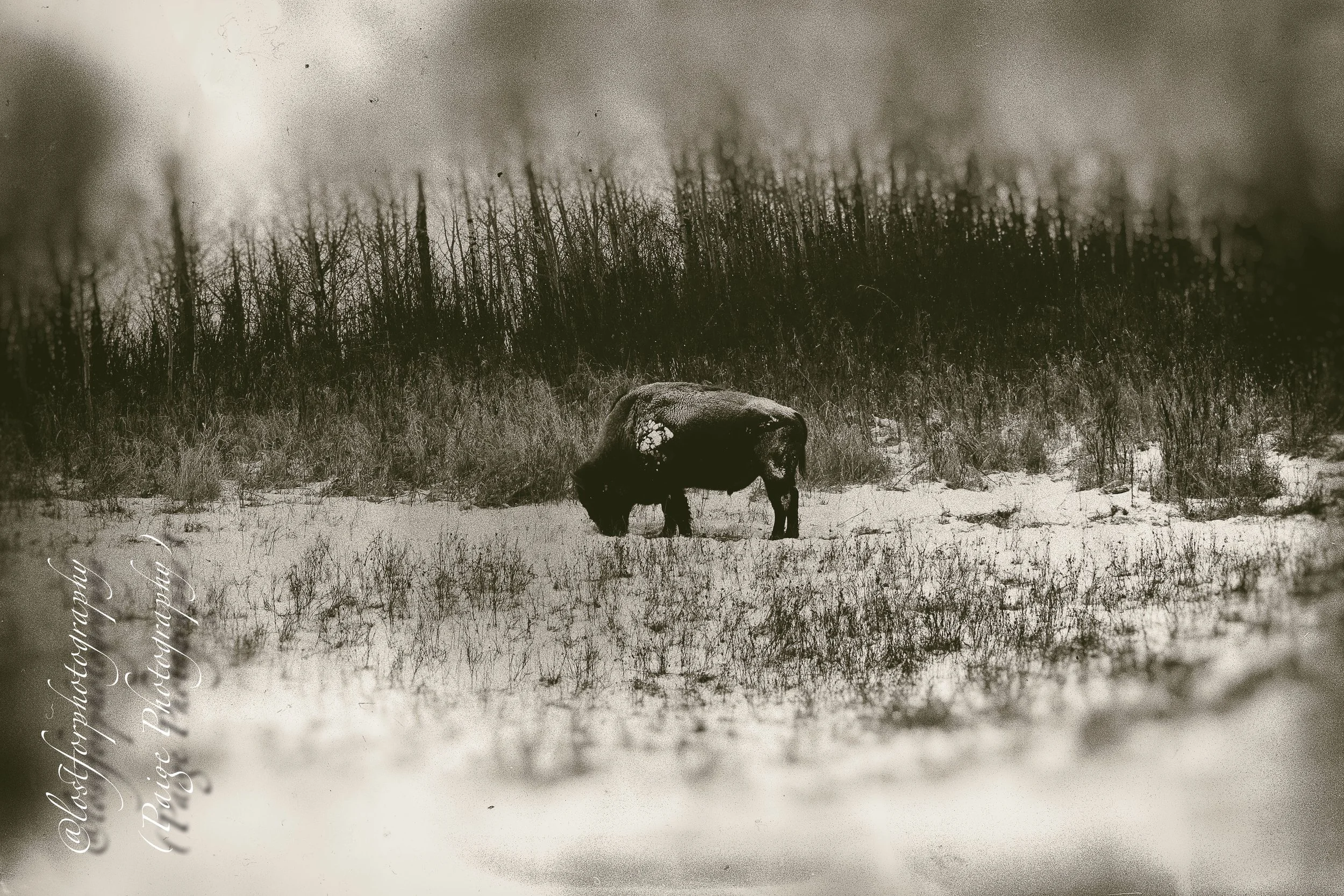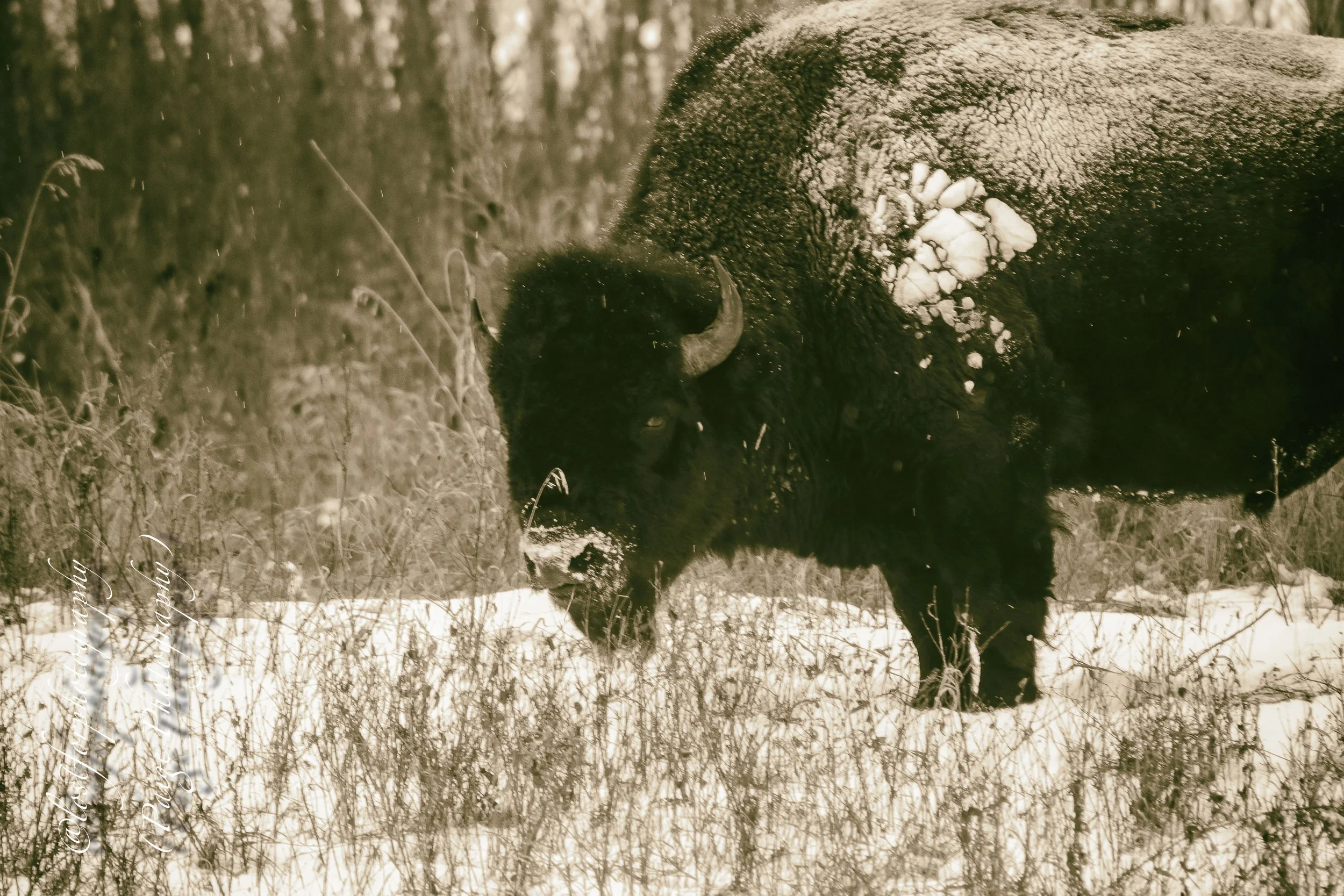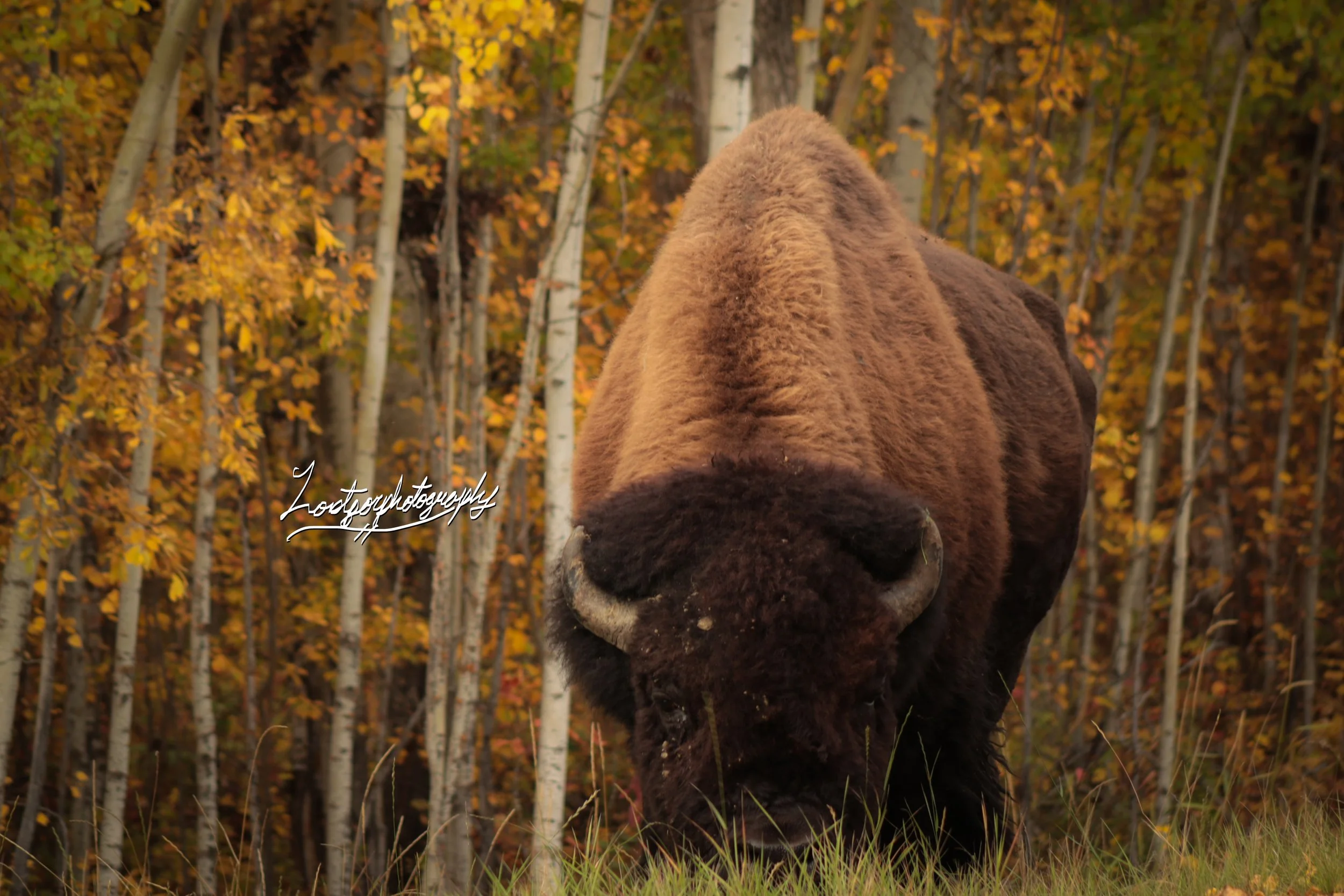Wildlife Part 1 - Plains Bison
Welcome to the start of a series of blog posts that I am doing with a collaboration of photographers from across Canada and around the world. Our goal in these blog posts is to share our love for wildlife photography but also to share some facts of some of the wildlife we have encountered. Some of the wildlife is in our own backyards such as mice, voles, and squirrels. Others is in National Parks in our area such as Elk Island National Park in Edmonton, Alberta, which is home to Wood Buffalo, Plains Bison, Elk, Moose, Wolves, and so much more. I’ll be kicking off this series with this first post with how I started in wildlife photography and will be sharing some of the first images I have ever gotten to the latest ones I have captured. Please enjoy this series of lessons, stories, and fun facts over the next incoming of weeks that is going to be shared by others. We hope you it enjoy it as much as we do.
Getting Started
Title: Wet Bison
Photographer: Paige Brenneis - Lost For Photography
The above image is from when I first started visiting Elk Island National Park in Edmonton, Alberta just off of the Yellowhead Trail. This park is outside of Edmonton by one hours drive and is in fact one of the most popular places to visit when you are near the city. It is home to Wood Buffalo, Plains Bison, Moose, Elk, Beaver, and so much more wildlife. Elk Island is a sanctuary for these animals to live freely and without fear of being hunted or harmed in anyway. The officials of the park have gone through great lengths to make this park enjoyable for all the visitors either passing through or stopping by to spend the day. When visiting, you do have to remember to respect the boundaries of the animals and obey the regulations of how to view them. These are not tamed animals, they are not pets, and they are still very much unpredictable. I say this because over my years of visiting this wonderful park, I have seen people fly through it, over the speed limit, and I have seen people try to walk up to the wildlife to take a selfie. Take your selfie from a safe distance as it is not only being respectful to the animals who live there, but it is also for your safety.
Be Bison Wise
This “Be Bison Wise” comes from the National Parks of Canada themselves and it is very important to remember.
Bison are wild animals. Even though they look docile, bison are dangerous, unpredictable, and may charge without warning. Keeping wildlife wild is a shared responsibility. Visitors have a responsibility to be informed and to explore the park in ways that ensure both visitor and wildlife are safe.
Follow these tips to enjoy each bison encounter safely at Elk Island National Park:
In a car
Drive slowly and bison will move out of the way
Do not honk, become impatient or drive aggressively. Attacks on vehicles are rare but can happen
Stop and view bison from a distance only if safe to do so. Stay in the vehicle. Watch for a few moments, take a quick photo, and move on
On foot or on bicycle
Be aware of surroundings and watch for wildlife
When approaching blind corners, proceed slowly in case a bison is just out-of-sight
Cyclists’ pair up with a motor vehicle to navigate past a bison in the ditch. Never ride through a herd on the road. Wait for the herd to move on or turn around.
Startled bison often run away, then stop and look back. Detour around any bison that remain in the area. Wait for bison to move, walk around the bison leaving space for them to escape, or back away slowly
Do not hike, bike, recreate, or cycle with ear buds. Pay attention to surroundings
Do not approach a bison closer than 100 metres and never try to chase or scare bison away
https://parks.canada.ca/pn-np/ab/elkisland/securite-safety/bison
I view these rules each time I go to keep it fresh in my mind especially for when I am hiking along the trails in the park. I am making it my goal to hike every trail and photograph the adventure as I go along. When being behind the camera it is easy to loose track of everything around you, to become absorbed with what you are seeing through your lens whether it is a chipmunk on a log or simply a wild flower. It has been said then when you are looking through a lens, you tend to not hear the world around you. Keep your ears open and be observant of your surrounding. I remember a friend telling me of a time when they hiked into a spot to photograph the sunset at Elk Island National Park and when they were finished, a herd of Bison was behind them. If I remember correctly, he knew they were there but didn’t fully hear them walk behind him. You have to be careful with Bison like the National Parks say. My friends story lives rent free in my mind as it is a great example of how to stay aware about the animals in the park. For more information please follow the link to the National Parks website and read up on some of the important facts about viewing Bison. There used to be chairs and a viewing point in Elk Island National Park called the Bison Loop. This loop has been closed a few times when I visited, due to road conditions, but also due to the time of the season. These chairs have been taken away now and there is no getting out of your vehicle to quietly sit there and enjoy the prairie view. You stop shortly, stay in your car, and view the Bison and then move along.
https://parks.canada.ca/pn-np/ab/elkisland/securite-safety/bison
Title: Sup Bison
Photographer: Paige Brenneis - Lost For Photography
Understand The Warning Signs
https://parks.canada.ca/pn-np/ab/elkisland/securite-safety/bison
Like every wild animal, Bison have a few distinct warning signs that everyone should be made aware of. These warning signs warn when you are getting to close and should start backing away slowly. They alert you when the situation or the animal mood has changed. I have linked the same link above but will share the warning signs to keep in mind here as well.
Animals have many warning signs: Dogs growl, cats hiss, and horses lay their ears back. Bison have various warning signs to watch out for.
Be alert and aware of bison warning signs and retreat slowly when bison:
Snorts, shakes or tosses its head
Raises its tail
Turns its back, raises its tail and defecates
Paws the ground
False charges
If bison stop grazing to stare, back away immediately until the animal returns to grazing
I have never put myself into a situation where this has happened thankfully and I never will as I respect the Bison and their home. The only time that I have seen Bison up close was in my car when going to view the Northern Lights with a friend of mine. Let me share this story with you now.
It was becoming dark, just after sunset, and my friend Vicky and I were on our way to Astotin Lake in Elk Island National Park to view the Aurora Borealis. Elk Island has been known for it’s great star gazing opportunities and for viewing the spectacular show of the Northern Lights. As we entered the park, we saw some cars pulled over to the side, waiting to get into this small parking lot that is for viewing, and there was a herd of Plains Bison off in the distance. As vehicles come and go, we waited our turn in the line to enter. We final got a chance to enter the viewing lot, parked for a second, and observed these magnificent animals as they travelled along. It was to dark to photograph any of them so we had to take the pictures with our minds. Quickly though, these animals have become closer and closer and before we knew it, they were around us. I turned off the vehicle, looked around at other motorists and everyone was in the same agreement. Nobody move, nobody make a sound, and stay very calm as these animals made their way to the next field across the road. As we were observing, I saw a Bison calf stop and look in our direction, curious on what we were doing. Had a good chuckle with my friend when we saw it’s mum head butt it along, nudging it to keep moving. I will never forget this experience because it was once in a lifetime. We heard the thunder of their hooves among the ground, felt the rumble of them through the floorboards of the car. It was breathtaking and quite a sight to behold. It really resonated with me ever since and I remember this time each time I visit the park. It goes to show how powerful these beautiful animals really are. They may be innocent and cuddly looking but I assure you that they are not, but you can enjoy them none the less.
Title: Dusty Nose
(Similar to Sup Bison)
Photographer: Paige Brenneis - Lost For Photography
What I Learned
I have learned a lot since 2017 when I started photographing more and more wildlife. I learned about the equipment you want to use, the exposure you set your camera for when wanting a certain type of effect. When I started, I was still very new to working a DSLR camera, shooting always in automatic. Now I never shoot in automatic, always in manual, and I am learning to still meter for the light, the whites, and for the shadows. With what I have learned, my Bison photography has improved quite a bit and I am pretty proud with how far I have come. I have friends and family who constantly tell me about my growth, on what they have observed. As I share my photography here, sell my photography on Etsy, and also have started sharing Wildlife Photography with my niece, I continue to learn and grow. I have shared my knowledge about the Bison with my niece, Hannah, and she found it quite interesting to learn. She had never seen Bison before 2024 when I took her to Elk Island for the first time. When she saw them, she could not believe how big these animals are. Plains Bison can be up to 12.5 feet long and weigh up to 2,000 pounds. Bulls are usually larger than cows. Bulls on Bison will also have larger horns than the cows whose horns are much smaller. You will see a bull Plains Bison at the end of this blog as it is the most recent image I have captured.
Gear you want if photographing any wildlife is a good telephoto lens. I know photographers who use a Prime 600mm lens which is a fixed focal length lens. These lenses can be quite pricey to purchase as I have gauged some of them around the $17,000CAN. What I use is a Sigma 150-600mm lens and it is one that comes everywhere with me. Now these lenses are heavy so a small light tripod will not due you very well. You want a heavy duty tripod, like the Manfrotto 528XB which is one of the heaviest Manfrotto tripods, with a load capacity of 110 lbs (50 kg). It's a single-stage tripod with stainless steel tubes and aluminum leg extensions.
Second, you want a camera that the lens can attach to. I use a Canon 5D Mk2 and a Canon 80D. I am currently looking into the decision of upgrading one of them to a mirrorless but will see that in the future. Any camera though will do. As some may say, “wow you have a great camera that takes great pictures!” Yes a camera can take great pictures but it is not just the camera, the brand of camera, or even the style of camera whether it is mirrorless, DSLR, or even film. There is still a photographer behind that camera with the skills they have learned, the knowledge they share, and the eye for the photo that is being taken.
Title: Eye of The Bison
Photographer: Paige Brenneis - Lost For Photography
The above image is one of my favorites I have ever captured when viewing the Plains Bison in Elk Island. This was in a trail with a 600mm lens and the herd was by some water as they grazed. This photo I didn’t know I had until years later. I have shared the story about this photo once before so I will not reshare it now. Instead I would like to share some of the photos I have captured over the years before sharing the newest one.
Title: Where The Bison Roam
Photographer: Paige Brenneis - Lost For Photography
Title: Bison In Yellow
Photographer: Paige Brenneis - Lost For Photography
Title: What Are You Looking At?
Photographer: Paige Brenneis - Lost For Photography
Title: Nah Nah Nah
Photographer: Paige Brenneis - Lost For Photography
The Main Story
I’ll keep this one short as there is not very much to say about how I went and got this photo. The day was January 31st, 2025 and Alberta was being hit by two days of continuous snow. A snow storm that was not quite a squall. My mum and I were driving down backroads trying to capture minimalistic scenery with the falling and blowing snow. Now I still have to edit those photos as there is a few techniques I was learning to try and having fun with. The snow began to fall harder and harder and the back roads were becoming very hard to define. You did not know where the edge of the road was and how deep some of the drifts were. Eventually we made it to a secondary highway and made our way to Redwater where we got a bite to eat. From there we took another secondary highway and a few other roads. Little did we know we would end up by Fort Saskatchewan so I mentioned we should swing by the National Park and see if we can get some Bison in the fresh snow. The park never disappoints and we did manage to get our photo. I even tried my hand at some videography. So here I was, sitting in a snowbank, legs frozen beyond feeling and there is three bull Plains Bison in a field, rooting for their food. The snow was deep and I got to observe these three handsome fellers rub their noses back and forth along the ground, tossing the snow aside to get to the grass below. When they lifted their head, their noses were all covered, their heads were not just dusted with snow on the top, and their backs were covered like a blanket. They were a sight and I managed to get some of the most amazing scenery photographs of the Bison yet. So without further adieu I will share them with you.
Title: Covered In Blue
Taken: January 31st, 2025
Photographer: Paige Brenneis - Lost For Photography
Title: Got Your Back Bro
Taken: January 31st, 2025
Photographer: Paige Brenneis - Lost For Photography
The Headlining Image
Title: Eye Spy
Taken: January 31st, 2025
Photographer: Paige Brenneis - Lost For Photography
Thank you for reading my post today. I hope you enjoyed the start of this series as much as I enjoyed sharing my knowledge, experiences, and stories I had to share. Please, take the time when you visit any National Park, wherever it may be, to read up on the animals that live there. Be respectful, be wise, and admire them from a safe distance. A selfie is not worth being hurt or killed over. Thank you for reading. I’ll leave the link one last time below.
Tschüss!











